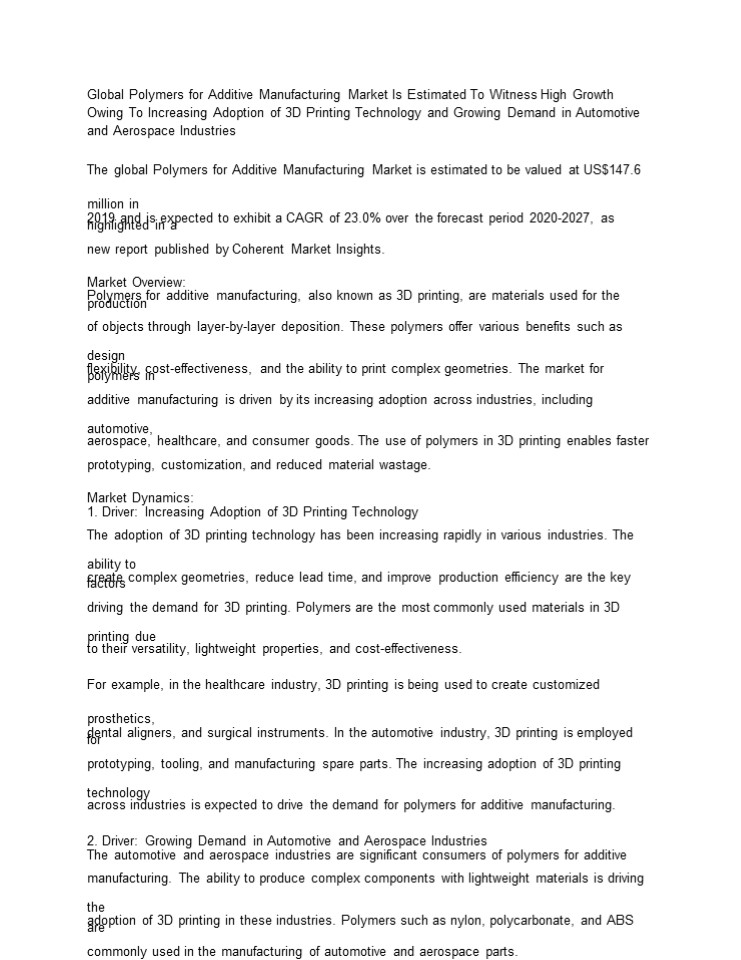Polymers For Additive Manufacturing Market - PowerPoint PPT Presentation
Title:
Polymers For Additive Manufacturing Market
Description:
Polymers For Additive Manufacturing Market – PowerPoint PPT presentation
Number of Views:0
Title: Polymers For Additive Manufacturing Market
1
Global Polymers for Additive Manufacturing Market
Is Estimated To Witness High Growth Owing To
Increasing Adoption of 3D Printing Technology and
Growing Demand in Automotive and Aerospace
Industries The global Polymers for Additive
Manufacturing Market is estimated to be valued at
US147.6 million in 2019 and is expected to
exhibit a CAGR of 23.0 over the forecast period
2020-2027, as highlighted in a new report
published by Coherent Market Insights. Market
Overview Polymers for additive manufacturing,
also known as 3D printing, are materials used for
the production of objects through layer-by-layer
deposition. These polymers offer various benefits
such as design flexibility, cost-effectiveness,
and the ability to print complex geometries. The
market for polymers in additive manufacturing is
driven by its increasing adoption across
industries, including automotive, aerospace,
healthcare, and consumer goods. The use of
polymers in 3D printing enables faster
prototyping, customization, and reduced material
wastage. Market Dynamics 1. Driver Increasing
Adoption of 3D Printing Technology The adoption
of 3D printing technology has been increasing
rapidly in various industries. The ability to
create complex geometries, reduce lead time, and
improve production efficiency are the key factors
driving the demand for 3D printing. Polymers are
the most commonly used materials in 3D printing
due to their versatility, lightweight
properties, and cost-effectiveness. For
example, in the healthcare industry, 3D printing
is being used to create customized prosthetics,
dental aligners, and surgical instruments. In
the automotive industry, 3D printing is employed
for prototyping, tooling, and manufacturing
spare parts. The increasing adoption of 3D
printing technology across industries is
expected to drive the demand for polymers for
additive manufacturing. 2. Driver Growing
Demand in Automotive and Aerospace Industries
The automotive and aerospace industries are
significant consumers of polymers for additive
manufacturing. The ability to produce complex
components with lightweight materials is driving
the adoption of 3D printing in these industries.
Polymers such as nylon, polycarbonate, and ABS
are commonly used in the manufacturing of
automotive and aerospace parts. For instance,
the aerospace industry utilizes 3D printing to
manufacture lightweight aircraft components,
reducing fuel consumption and improving overall
performance. In the automotive industry, 3D
printing is utilized for manufacturing
prototypes, custom parts, and lightweight
components. The growing demand for lightweight
and fuel-efficient vehicles in these industries
is expected to boost the market for polymers in
additive manufacturing. SWOT Analysis -
Strengths 1. Design Flexibility Polymers for
additive manufacturing offer design flexibility,
allowing the creation of complex geometries that
cannot be achieved through traditional
manufacturing methods.
2
2. Cost-Effectiveness 3D printing with polymers
significantly reduces material wastage and
production costs compared to conventional
manufacturing processes. - Weaknesses 1.
Limited Material Options The range of materials
available for 3D printing is limited compared to
traditional manufacturing methods. 2. Quality
Control Challenges Ensuring consistent quality
and performance of 3D printed parts can be
challenging due to variations in printing
parameters and machine calibration. -
Opportunities 1. Customization and
Personalization The ability to create highly
customized products through 3D printing presents
opportunities in various industries, including
healthcare, consumer goods, and fashion. 2.
Material Development Ongoing research and
development for new polymer materials with
improved properties and functionalities present
opportunities for growth in the market. -
Threats 1. Intellectual Property Infringement
The ease of replicating and sharing 3D designs
poses a risk of intellectual property
infringement. 2. Regulatory Challenges The lack
of standardized regulations for 3D printing and
polymers in additive manufacturing may pose
challenges for widespread adoption. Key
Takeaways - The global polymers for additive
manufacturing market is expected to witness high
growth, exhibiting a CAGR of 23.0 over the
forecast period, due to the increasing adoption
of 3D printing technology and growing demand in
the automotive and aerospace industries. - In
terms of regional analysis, North America is
expected to dominate the market due to the
presence of key players, technological
advancements, and early adoption of 3D printing
technology. Europe and Asia Pacific are also
expected to witness significant growth in the
market. - Key players operating in the global
polymers for additive manufacturing market
include Arkema S.A., Covestro AG, DuPont, Inc.,
EOS GmbH, Evonik Industries AG, INTAMSYS,
Prototal Industries, Stratasys Ltd., BASF SE,
Saudi Basic Industries Corporation (SABIC),
Huntsman International LLC, and NatureWorks LLC.































